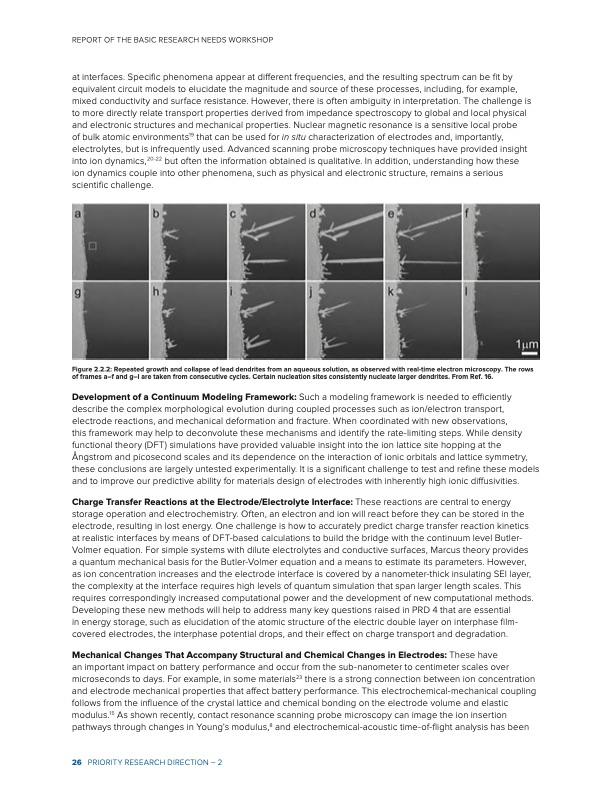
PDF Publication Title:
Text from PDF Page: 032
REPORT OF THE BASIC RESEARCH NEEDS WORKSHOP at interfaces. Specific phenomena appear at different frequencies, and the resulting spectrum can be fit by equivalent circuit models to elucidate the magnitude and source of these processes, including, for example, mixed conductivity and surface resistance. However, there is often ambiguity in interpretation. The challenge is to more directly relate transport properties derived from impedance spectroscopy to global and local physical and electronic structures and mechanical properties. Nuclear magnetic resonance is a sensitive local probe of bulk atomic environments19 that can be used for in situ characterization of electrodes and, importantly, electrolytes, but is infrequently used. Advanced scanning probe microscopy techniques have provided insight into ion dynamics,20-22 but often the information obtained is qualitative. In addition, understanding how these ion dynamics couple into other phenomena, such as physical and electronic structure, remains a serious scientific challenge. Figure 2.2.2: Repeated growth and collapse of lead dendrites from an aqueous solution, as observed with real-time electron microscopy. The rows of frames a–f and g–l are taken from consecutive cycles. Certain nucleation sites consistently nucleate larger dendrites. From Ref. 16. Development of a Continuum Modeling Framework: Such a modeling framework is needed to efficiently describe the complex morphological evolution during coupled processes such as ion/electron transport, electrode reactions, and mechanical deformation and fracture. When coordinated with new observations, this framework may help to deconvolute these mechanisms and identify the rate-limiting steps. While density functional theory (DFT) simulations have provided valuable insight into the ion lattice site hopping at the Ångstrom and picosecond scales and its dependence on the interaction of ionic orbitals and lattice symmetry, these conclusions are largely untested experimentally. It is a significant challenge to test and refine these models and to improve our predictive ability for materials design of electrodes with inherently high ionic diffusivities. Charge Transfer Reactions at the Electrode/Electrolyte Interface: These reactions are central to energy storage operation and electrochemistry. Often, an electron and ion will react before they can be stored in the electrode, resulting in lost energy. One challenge is how to accurately predict charge transfer reaction kinetics at realistic interfaces by means of DFT-based calculations to build the bridge with the continuum level Butler- Volmer equation. For simple systems with dilute electrolytes and conductive surfaces, Marcus theory provides a quantum mechanical basis for the Butler-Volmer equation and a means to estimate its parameters. However, as ion concentration increases and the electrode interface is covered by a nanometer-thick insulating SEI layer, the complexity at the interface requires high levels of quantum simulation that span larger length scales. This requires correspondingly increased computational power and the development of new computational methods. Developing these new methods will help to address many key questions raised in PRD 4 that are essential in energy storage, such as elucidation of the atomic structure of the electric double layer on interphase film- covered electrodes, the interphase potential drops, and their effect on charge transport and degradation. Mechanical Changes That Accompany Structural and Chemical Changes in Electrodes: These have an important impact on battery performance and occur from the sub-nanometer to centimeter scales over microseconds to days. For example, in some materials23 there is a strong connection between ion concentration and electrode mechanical properties that affect battery performance. This electrochemical-mechanical coupling follows from the influence of the crystal lattice and chemical bonding on the electrode volume and elastic modulus.15 As shown recently, contact resonance scanning probe microscopy can image the ion insertion pathways through changes in Young’s modulus,8 and electrochemical-acoustic time-of-flight analysis has been 26 PRIORITY RESEARCH DIRECTION – 2PDF Image | Next Generation Electrical Energy Storage

PDF Search Title:
Next Generation Electrical Energy StorageOriginal File Name Searched:
BRN-NGEES_rpt-low-res.pdfDIY PDF Search: Google It | Yahoo | Bing
Sulfur Deposition on Carbon Nanofibers using Supercritical CO2 Sulfur Deposition on Carbon Nanofibers using Supercritical CO2. Gamma sulfur also known as mother of pearl sulfur and nacreous sulfur... More Info
CO2 Organic Rankine Cycle Experimenter Platform The supercritical CO2 phase change system is both a heat pump and organic rankine cycle which can be used for those purposes and as a supercritical extractor for advanced subcritical and supercritical extraction technology. Uses include producing nanoparticles, precious metal CO2 extraction, lithium battery recycling, and other applications... More Info
| CONTACT TEL: 608-238-6001 Email: greg@infinityturbine.com | RSS | AMP |